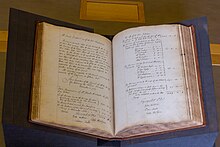William Brouncker, 2nd Viscount Brouncker
This article includes a list of general references, but it lacks sufficient corresponding inline citations. (October 2020) |
The Viscount Brouncker | |
|---|---|
 | |
| President of the Royal Society | |
| In office 1662–1677 | |
| Preceded by | Office established |
| Succeeded by | Joseph Williamson |
| Personal details | |
| Born | c. 1620 civil servant |
| Institutions | Saint Catherine's Hospital |
| Academic advisors | John Wallis |

William Brouncker, 2nd Viscount Brouncker
Biography
Brouncker was born c. 1620 in
William obtained a
Although his attendance at the Royal Society had become infrequent, and he had quarrelled with some of his fellow members, he was nonetheless greatly displeased to be deprived of the presidency in 1677. He was commissioner for executing the office of
Abigail Williams
Brouncker never married, but lived for many years with the
On Brouncker's death in 1684, his title passed to his brother Henry, one of the most detested men of the era. William left him almost nothing in his will "for reasons I think not fit to mention".
Mathematical works
His mathematical work concerned in particular the calculations of the lengths of the
Brouncker's formula
This formula provides a development of π/4 in a generalized continued fraction:
The convergents are related to the
and
Because of its slow convergence, Brouncker's formula is not useful for practical computations of π.
Brouncker's formula can also be expressed as[4]
See Euler's continued fraction formula.
See also
References
- ^ "No. 1485". The London Gazette. 9 February 1679. p. 2.
- Philosophical Transactions of the Royal Society of London, abridged edition 1809, v. i, pp 233–6, link form Biodiversity Heritage Library
- ^ Julian Coolidge Mathematics of Great Amateurs, chapter 11, pp. 136–46
- ^ John Wallis, Arithmetica Infinitorum, ... (Oxford, England: Leon Lichfield, 1656), page 182. Brouncker expressed, as a continued fraction, the ratio of the area of a circle to the area of the circumscribed square (i.e., 4/π). The continued fraction appears at the top of page 182 (roughly) as: ☐ = 1 1/2 9/2 25/2 49/2 81/2 &c , where the square denotes the ratio that is sought. (Note: On the preceding page, Wallis names Brouncker as: "Dom. Guliel. Vicecon, & Barone Brouncher" (Lord William Viscount and Baron Brouncker).)
External links
- O'Connor, John J.; Robertson, Edmund F., "William Brouncker, 2nd Viscount Brouncker", MacTutor History of Mathematics Archive, University of St Andrews
- . Dictionary of National Biography. London: Smith, Elder & Co. 1885–1900.




